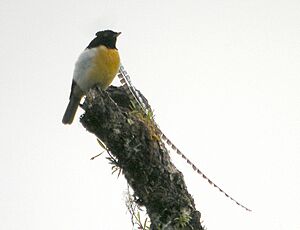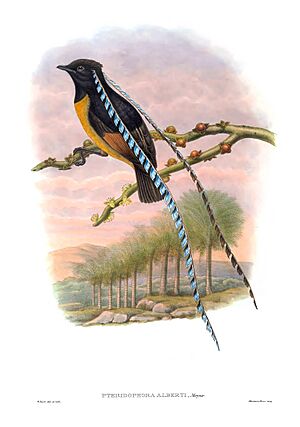King of Saxony bird-of-paradise facts for kids
Quick facts for kids King of Saxony bird-of-paradise |
|
|---|---|
 |
|
| Male in Papua New Guinea | |
| Conservation status | |
| Scientific classification | |
| Genus: |
Pteridophora
|
| Species: |
alberti
|
| Subspecies | |
|
P. a. alberti |
|
The King of Saxony bird-of-paradise (Pteridophora alberti) is a very unique bird. It is part of the amazing bird-of-paradise family. This bird is the only one of its kind in the genus called Pteridophora. You can only find it in the mountain forests of New Guinea.
Contents
What's in a Name?
A scientist named Adolf Bernard Meyer first described this bird. He worked at the Dresden Museum. He wrote about it in December 1894.
Both the common name "King of Saxony" and its scientific name, alberti, honor a king. They were named after Albert, King of Saxony. His wife also had a bird named after her, the Queen Carola's parotia.
What Does It Look Like?
An adult King of Saxony bird-of-paradise is about 22 centimeters (9 inches) long. The male bird is black and yellow. It has dark brown eyes and brownish-grey legs. Its beak is black with a bright aqua-green mouth area.
The most amazing part is its head. Males have two super long feathers, up to 50 centimeters (20 inches) long! These feathers look like blue ribbons with scallops. The bird can move each of these special feathers by itself. The female bird looks much simpler. She is greyish-brown with stripes on her belly.
When the first male bird was brought to Europe, people thought it was fake. Its head feathers were so strange!
Where Do They Live?
The King of Saxony bird-of-paradise lives in the mountain forests of New Guinea. You can find them from the Weyland Mountains in Western New Guinea to the Kratke Range. They also live near Mount Giluwe in Papua New Guinea.
These birds usually live at high altitudes. They are found between 1,800 and 2,500 meters (about 5,900 to 8,200 feet) above sea level.
Sometimes, male Archbold's bowerbirds collect the fallen head plumes. They use them to decorate their special courtship areas. People also collect these long feathers. Local people use them for ceremonies. Even though they are hunted, these birds are still quite common. They are listed as a species of least concern by the IUCN Red List of Threatened Species.
How Do They Behave?
Adult male birds have their own territories. They guard their areas from high up in tall trees. From these spots, they sing to other males nearby. While singing, the male moves its long head plumes around. In 1996, David Attenborough filmed the first video of this bird's mating dance.
These birds mostly eat fruits, berries, and small insects.
Courtship and Reproduction
The male King of Saxony bird-of-paradise has a special way to attract females. It uses its unique feathers and makes sounds. Its long head feathers are very special. They are not like normal feathers. They are like amazing decorations. These feathers can be twice as long as the male's body.
Females choose males based on these feathers. This is because the male does not help raise the babies. So, the female needs to pick a strong, healthy male. She judges him by his courtship dance.
Song and Dance
Male King of Saxony birds sing from high in the forest trees. They spread out in an "exploded lek." This means males are far apart but still in one general area. This allows females to visit different males easily. The songs sound like "radio-static hisses." They last about four to five seconds. Males repeat their songs every minute until a female arrives.
When a female comes close, the male starts his dance. He moves his amazing head plumes up and down. This is to get her attention. These huge feathers are key to his show. Then, he bounces his chest and back feathers. If the female likes what she sees, she follows him. They go to the lower part of the forest.
Here, the male sits on a vine below the female. He bounces up and down. This makes her vine shake. If she is still interested, he hops next to her. He raises his chest feathers. Then, he wags his head from side to side. This makes his long head wires swirl around the female. These dances happen most often between July and February.



